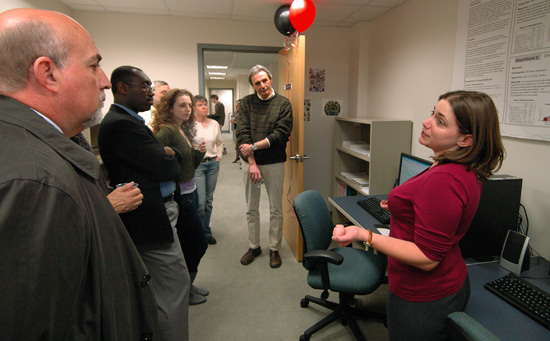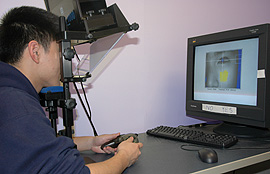Psychology Department Showcases New Laboratories
 |
| Barbara Juhasz, at right, assistant professor of psychology and neuroscience and behavior, explains eye-tracking data to guests during a roving lab event Jan. 23. |
| Posted 02/01/08 |
| Three new psychology labs in Judd Hall allow faculty and students to study readers’ habits, to reveal insights into children’s’ minds and to help improve existing treatments for schizophrenia.The Department of Psychology hosted a roving lab event Jan. 23 to introduce the labs and showcase the extensive renovations that were completed to create customized multi-purpose facilities.
The renovations include Barbara Juhasz’s eye tracking lab on the fifth floor, Anna Shustermans child development lab on the fourth, and Matthew Kurtzs cognitive testing and treatment lab for people with schizophrenia on the third floor. Ruth Striegel-Moore, professor and chair of psychology, expressed her excitement about the spaces and her gratitude to Joe Bruno, vice president for academic affairs and provost, and David Bodznick, dean of natural sciences and mathematics, for their support. Joe supported what I consider a radical transformation of our space, Striegel-Moore says. The space is an exact execution of the design needs of the faculty. Striegel-Moore said that each of the renovations were a wonderful example of what can be achieved when people work together for a common goal. Wesleyan is committed to hiring outstanding faculty members with ambitious research agendas and a strong commitment to undergraduate education in the classroom and in the research laboratory, Bruno says. We are pleased to have hired several outstanding new faculty members in the department of psychology recently, and look forward to their contributions to the Wesleyan community. The fifth floor space was previously a holding area for animals involved in research and has largely been unused for years. Today, the floor that Striegel-Moore said used to be a dingy dark space with a 1930s-feel is now brightly lit and professional looking. The floor contains Juhaszs office, three testing areas, a lounge, temporary faculty offices and the office of the departments budget and grants coordinator.
Having newly renovated labs to move into and generous funding to purchase equipment gives new faculty the opportunity to hit the ground running with their research and to involve undergraduates and graduate students in that research without significant delays, Bodznick says. The renovation led by Alan Rubacha, consultant in the construction services department, began in the spring of 2006 and was completed just before the fall semester began in 2006. Brandi Hood, senior project coordinator in the construction services department, was responsible for the work on the fourth and third floors. Planning for the lower floors began in May 2007 and the renovations were completed by August 2007. Hood said that her design challenge was to meet university standards while matching the rooms to her clients functional needs and stylistic requests. For example, although Hood doesnt normally design childrens labs, Shusterman says she is pleased that the lab looks exactly as she intended it to look. The real challenge in a project of this nature is to quickly determine the faculty’s needs, formulate the design and execute the construction project within the time and space allocated, Hood says. The fourth floor looks very different from the animal facility it once was. One cant help but notice the inviting, kid-friendly light blue walls. The new lab has a computer room for undergraduates, Shustermans office, a common area and two observation laboratories dedicated to child development experiments. One particular challenge for Hood and Shusterman was creating the navigation rooma largely neutral 12-foot-by-12-foot room with a stimulus-free environment where childrens spatial reasoning abilities are tested. Not only did she need a room that could fit a customized off-white movable curtain, she needed everything in the room to be as symmetrical as possible so that kids could not use anything in the environment around them to assist them during the experiments. In fact, Shusterman requested that two vents be placed in the ceiling to match the vents already in existence. The room had to look the same no matter what area youre looking at, Hood says. The third floor, which used to hold a sleep lab, now houses Kurtzs office and two rooms outfitted with computers and used for research involving people with schizophrenia. The lab will be devoted to the cognitive and social-cognitive training of people with schizophrenia. Kurtz conducts assessments of patients associated with the Institute of Living in Hartford and plans to bring individuals with schizophrenia to his lab so they can participate in in-depth training programs to help improve any deficits they may have with attention, memory, problem solving and other cognitive and psychosocial functions. Striegel-Moore said the design challenge for Kurtzs space was to create a warm, calm lab, nothing very institutional. Its an incredible space, Kurtz says. Bruno agrees. Our investment in facilities and equipment ensures that these colleagues will have the support they need for their research and teaching, Bruno says. It also provides for the best use of Judd Hall, an important part of Wesleyans brownstone row. |
| By Corrina Balash Kerr, associate director of media relations. Photos by Olivia Drake. |


 Juhasz said she was especially happy to get the Eye Link 1000 eye-tracking machine installed (pictured at left). According to Juhasz, eye tracking used to be a technique that only a few people could do because the old, large machines used to be so expensive. With the new machine, researchers can record a readers eye movements every millisecond and learn more about sentence comprehension, compound word recognition and the overall process of reading.
Juhasz said she was especially happy to get the Eye Link 1000 eye-tracking machine installed (pictured at left). According to Juhasz, eye tracking used to be a technique that only a few people could do because the old, large machines used to be so expensive. With the new machine, researchers can record a readers eye movements every millisecond and learn more about sentence comprehension, compound word recognition and the overall process of reading.